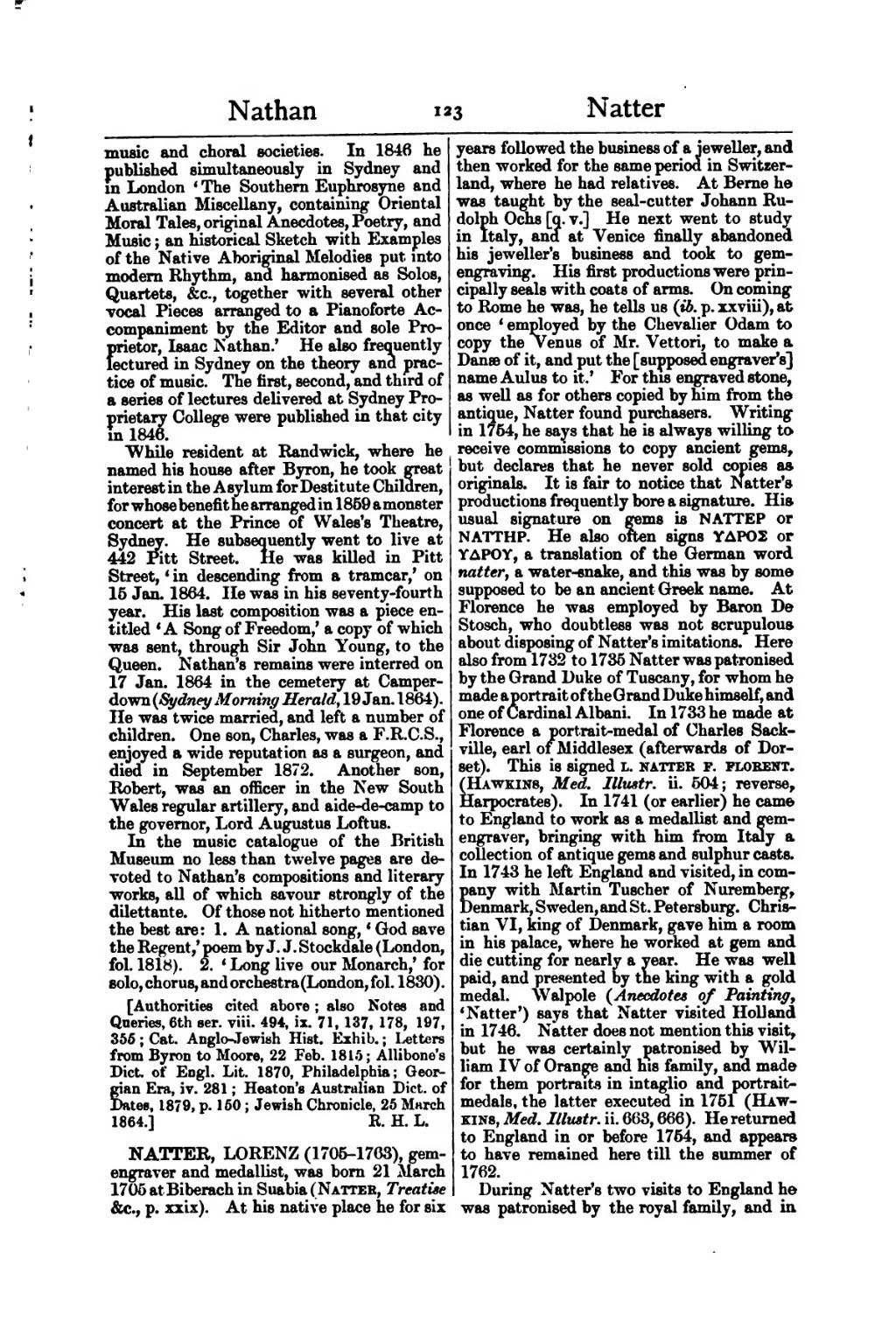music and choral societies. In 1846 he published simultaneously in Sydney and in London ‘The Southern Euphrosyne and Australian Miscellany, containing Oriental Moral Tales, original Anecdotes, Poetry, and Music; an historical Sketch with Examples of the Native Aboriginal Melodies put into modern Rhythm, and harmonised as Solos, Quartets, &c., together with several other vocal Pieces arranged to a Pianoforte Accompaniment by the Editor and sole Proprietor, Isaac Nathan.’ He also frequently lectured in Sydney on the theory and practice of music. The first, second, and third of a series of lectures delivered at Sydney Proprietary College were published in that city in 1846.
While resident at Randwick, where he named his house after Byron, he took great interest in the Asylum for Destitute Children, for whose benefit he arranged in 1859 a monster concert at the Prince of Wales's Theatre, Sydney. He subsequently went to live at 442 Pitt Street. He was killed in Pitt Street, ‘in descending from a tramcar,’ on 15 Jan. 1864. He was in his seventy-fourth year. His last composition was a piece entitled ‘A Song of Freedom,’ a copy of which was sent, through Sir John Young, to the Queen. Nathan's remains were interred on 17 Jan. 1864 in the cemetery at Camperdown (Sydney Morning Herald, 19 Jan. 1864). He was twice married, and left a number of children. One son, Charles, was a F.R.C.S., enjoyed a wide reputation as a surgeon, and died in September 1872. Another son, Robert, was an officer in the New South Wales regular artillery, and aide-de-camp to the governor, Lord Augustus Loftus.
In the music catalogue of the British Museum no less than twelve pages are devoted to Nathan's compositions and literary works, all of which savour strongly of the dilettante. Of those not hitherto mentioned the best are: 1. A national song, ‘God save the Regent,’ poem by J. J. Stockdale (London, fol. 1818). 2. ‘Long live our Monarch,’ for solo, chorus, and orchestra (London, fol. 1830).
[Authorities cited above; also Notes and Queries, 6th ser. viii. 494, ix. 71, 137, 178, 197, 355; Cat. Anglo-Jewish Hist. Exhib.; Letters from Byron to Moore, 22 Feb. 1815; Allibone's Dict. of Engl. Lit. 1870, Philadelphia; Georgian Era, iv. 281; Heaton's Australian Dict. of Dates, 1879, p. 150; Jewish Chronicle, 25 March 1864.]
NATTER, LORENZ (1705–1763), gem-engraver and medallist, was born 21 March 1705 at Biberach in Suabia (Natter, Treatise &c., p. xxix). At his native place he for six years followed the business of a jeweller, and then worked for the same period in Switzerland, where he had relatives. At Berne he was taught by the seal-cutter Johann Rudolph Ochs [q. v.] He next went to study in Italy, and at Venice finally abandoned his jeweller's business and took to gem-engraving. His first productions were principally seals with coats of arms. On coming to Rome he was, he tells us (ib. p. xxviii), at once ‘employed by the Chevalier Odam to copy the Venus of Mr. Vettori, to make a Danae of it, and put the [supposed engraver's] name Aulus to it.’ For this engraved stone, as well as for others copied by him from the antique, Natter found purchasers. Writing in 1754, he says that he is always willing to receive commissions to copy ancient gems, but declares that he never sold copies as originals. It is fair to notice that Natter's productions frequently bore a signature. His usual signature on gems is NATTEP or NATTHP. He also often signs YΔROΣ or YΔROY, a translation of the German word natter, a water-snake, and this was by some supposed to be an ancient Greek name. At Florence he was employed by Baron De Stosch, who doubtless was not scrupulous about disposing of Natter's imitations. Here also from 1732 to 1735 Natter was patronised by the Grand Duke of Tuscany, for whom he made a portrait of the Grand Duke himself, and one of Cardinal Albani. In 1733 he made at Florence a portrait-medal of Charles Sackville, earl of Middlesex (afterwards of Dorset). This is signed L. Natter F. Florent. (Hawkins, Med. Illustr. ii. 504; reverse, Harpocrates). In 1741 (or earlier) he came to England to work as a medallist and gem-engraver, bringing with him from Italy a collection of antique gems and sulphur casts. In 1743 he left England and visited, in company with Martin Tuscher of Nuremberg, Denmark, Sweden, and St. Petersburg. Christian VI, king of Denmark, gave him a room in his palace, where he worked at gem and die cutting for nearly a year. He was well paid, and presented by the king with a gold medal. Walpole (Anecdotes of Painting, ‘Natter’) says that Natter visited Holland in 1746. Natter does not mention this visit, but he was certainly patronised by William IV of Orange and his family, and made for them portraits in intaglio and portrait-medals, the latter executed in 1751 (Hawkins, Med. Illustr. ii. 663, 666). He returned to England in or before 1754, and appears to have remained here till the summer of 1762.
During Natter's two visits to England he was patronised by the royal family, and in

